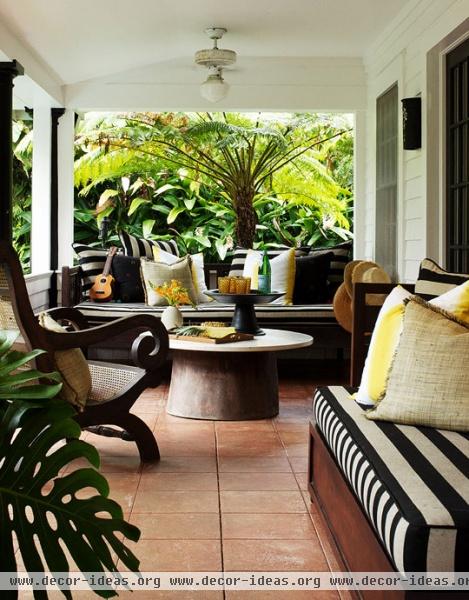Tropical Traditional Home

Tropical Traditional Home
Design:
Interior Design: Marion Philpotts Miller, Philpotts & Assoc. Inc., 40 S. School St., Suite 200, Honolulu, HI 96813; 808/523-6771; and 643 Seventh St., San Francisco, CA 94103; 415/621-5888, philpotts.net.
Photographs by Joe Schmelzer
Text by Candace Ord Manroe
Produced by Krissa Rossbund
Right next door to her mother's home, on a smaller lot bracketed by the same brisk stream and bamboo forest, Marion Philpotts Miller celebrates a family tradition of Hawaiian design. "Growing up with a designing mother, I assimilated lessons without even knowing it," says the second-generation interior designer and Oahu-born Hawaiian. "It was only when I started traditional design schooling that I realized the foundation had already been laid."
Yet there is a difference between mother and daughter's take on a common heritage: "I edit what I grew up with through a different set of lenses," suggests Marion. Her lenses are tempered with 25 years of living in San Francisco. "I have all of the tropical influences and the love of indigenous materials, but I also bring a little more of the edginess and youthfulness that comes from having lived in a more urban environment."
Like Hawaii itself, Marion's fresh look is ideal for raising a family. When she moved back to Honolulu with husband Jeff 10 years ago, their daughters, Marée and Makena, were only 5 and 9. "There's no better place in the world for children to grow up," attests Marion.
Still, much of what's edgy in her style takes its cues from the tropical environment. In the living room, it's the ceiling-mounted lavender pod light fixture, which suggests some exotic species of flora plucked, still moist, from the rain forest floor. "I try to include something in every room that will be a memory maker," says the designer. "This piece is fun, fresh, and almost organic. It's so sculptural that it becomes a strong art statement. Because it's on the center axis, it's the room's natural focal point." To integrate the dramatic fixture into the room, she tinted the previously taupe walls a pale, barely perceptible lavender.
In the dining room, the nature-derived zing comes from color itself. "It's so rich and wet where we live that red was the natural punch for the palette. I used it on accents in the living room, then brought it to the walls as the memory maker for the dining room. It's a happy color." No worries should the family tire of such a robust red on the walls--Marion will have changed paint colors long before that. "Before the red, the walls were chartreuse. I think I will probably go with indigo next."
For an enclosed sun porch, she painted the walls green. "In Hawaii, it's all about the indoor-outdoor connection," she explains. Porches, called lanais, are "the preferred places to hang out," says Marion, "because they capture the trade winds." The preferred seating is a punaee, or daybed. "We have one in our enclosed sun porch, and also on the porch itself. My mom also has one in her kitchen."
Like her mother, Marion enjoys designing with furniture that tells a story--in her case, the family's story. "We have a zillion hand-me-downs. The sofas were my grandmother's, as were the dining room table, chairs, and sideboard. Nobody wanted them, so we inherited them by default. But when you put these older furnishings in a context with contemporary art, they become fresh."
Also like her mother--and, as such, true to Hawaiian style--Marion pays homage to Asian cultures in her design. "Hawaii is exotic. When you look at the cultural language that exists, it's a melding of Japanese, Balinese, and Chinese all into one. Historically, Hawaii was a melting pot," Marion explains. In her family room, a sleek new red lacquer desk from Bali teams up with a folk-art Chinese wooden chair. On the bookshelves to the side, a Buddha bust and Balinese boxes attest to the Asian influence.
"I've also used black and white, which is very Asian," notes Marion. Plumped with black-and-white cushions, the fire pit's circle of black chairs are surmounted by Balinese silver woven globes strung from tree branches and illuminated at night. "There used to be a lot of importing to Hawaii, so our style tells stories of our rich heritage. The challenge is how to tell the story in a fresh way, so it doesn't feel tired and dowdy."
No such danger for Marion, who gravitates to a tightly edited graphic style. "I'm not a collector," she observes. "That's one way I exercise restraint. My style is more distilled than my mom's." An example is her revamped kitchen. Its island and window seat, each 11 feet long, parallel the new raised ceiling's grid for linear drama. "It's a little more severe and urbane than my mom's style."
But like her mother's, Marion's style--at least at home--is ultimately Hawaiian. "There's no formal preciousness to how we live here--just this wonderful embracing of what's been handed down. And it all begins with being true to the environment."
Sources:
Furnishings and accessories: owner's collection.












